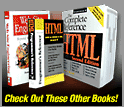

 |
 |
|||

|
Chapter 1: What Is Web Design?
Learning Web Design
Reading a book like this is useful in uncovering the theories and commonly held practices of Web design, but more is required if you are to ever achieve mastery of Web design. Always remember that learning the basics of Web site development is not necessarily difficult, but do not underestimate the time and effort it will take to become an accomplished designer. This is no different from carpentry, painting, writing, illustration, or just about any skill you can think of. So make sure you set reasonable expectations for yourself as you learn.One useful approach to learning Web design is by evaluating the efforts of others. We can look at what is done right and what is done wrong and try to emulate the good and fix the bad. Beware, however: it is not always easy to evaluate and compare site designs. Far too often people compare that which is not comparable. You would never compare a video game with a word processor, yet both are software programs. Why, then, do we compare experimental sites with corporate sites, or e-commerce sites with Web design agency portfolio sites? Far too often, this type of comparison is done in the Web design community. Sites and books put forward a variety of sites as absolute yardsticks of great design. Yet, obviously, not all sites will have the same issues as those that the "excellent design" rules were derived from. What is cool or clever for one site may be an absolute disaster for another. A great example is the splash page shown in Figure 1-9. A splash page is the term used to describe an entry page to a site—one that comes before the actual home or core page of the site.
A splash page is often used to set the tone for the site and may consist of an interesting animation, preloading sequence, or some form of "installation" information in regards to what technology is required or what the user's expectations should be. While splash pages can be effective, very often they are not. The mere mention of the phrase "skip intro" results in hearty chuckles among many designers. Yet the much maligned splash page may just happen to have some uses. Some movie and entertainment sites have found such sequences to be an integral aspect of their sites. Just like a movie without opening credits, these sites would be incomplete without a splash page. This simple example illustrates the most dangerous problem facing those learning Web design— namely, assuming there is only one form of good Web design. Often, it seems that the only absolute in a fluid discipline like Web design is that there is no absolute. Rule: There is no form of "correct" Web design that fits every site. As you read this book, you'll notice that various rules and suggestions are presented. These are fairly safe and well thought out, but their real value comes from understanding the motivation for them, not from blindly applying them. The importance of this distinction will become apparent once you see that many of the "rules" seem at odds with other rules. Exhibiting good judgment that strikes a balance between conflicts is a key attribute of a great Web designer. A discussion of site evaluations that attempts to cover all aspects of Web design from taste to technical implementation can be found in Chapter 5, and a checklist useful during such site evaluations is presented in Appendix B. Yet do not fall into the trap of becoming a professional critic. Certainly it is important to point out what not to do by finding flaws in sites or criticizing what is bad, but spending too much time discussing bad Web design may not be fruitful, particularly when you consider that there is no accounting for poor taste. It is easy to criticize, but it is much more difficult to take your acquired knowledge and apply it to a site of your own. In the final analysis, the best approach to learning Web design is obviously by doing. Reading about site design theory or reviewing sites simply isn't a replacement for building sites of your own. Yet before you set out constructing a site, learn the core principles of Web design as well as the building and evaluation procedures that will help you construct your Web sites well. Next: Summary
|
Overview | Chapters | Examples | Resources | Buy the Book! |